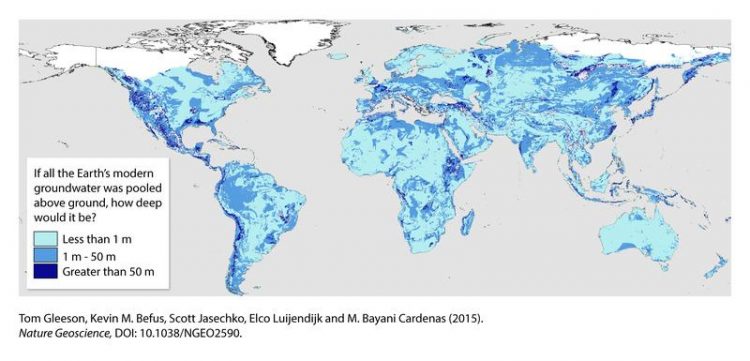First quantification of Earth’s groundwater

Model: The amount of 23 million cubic kilometers of groundwater is enough to cover the global land surface in a layer 180 metres deep. Photo: University of Victoria
An international team of scientists with participation from the University of Göttingen has produced the first data-driven estimate of the Earth’s total supply of groundwater.
The study shows that the total volume of groundwater of any age is about 23 million cubic kilometres. However, less than six percent of the total amount is modern groundwater that is replenished within a human lifetime.
Some of the largest volumes of modern groundwater are in the Amazon Basin, the Congo, Indonesia, and in mountain chains like the Rocky Mountains, the least amount is not surprisingly in more arid regions such as the Sahara.
The study was conducted by the Universities of Victoria, Calgary (both Canada), Austin (Texas) and Göttingen (Germany) and published in Nature Geoscience.
Groundwater is one of the planet’s most exploited and most precious natural resources. Around the world, there is increasing demand to know how much we have and how long before it is tapped out.
“The amount of 23 million cubic kilometers is enough to cover the global land surface in a layer 180 metres deep,” explains Dr. Elco Luijendijk from Göttingen University’s Geoscience Centre.
“Although the volume of modern groundwater may appear small at first glance, it is still much larger than all other components of the active hydrological cycle such as water in rivers, lakes, and the atmosphere.”
The study combined measurements of radioactive tritium introduced to the groundwater by nuclear tests in the 1950’s with computer models of groundwater flow in the upper two kilometres of the subsurface.
“Knowing the volume of modern groundwater is important because it is a more renewable resource than older stagnant groundwater,” says Dr. Luijendijk. “However, modern groundwater is also more vulnerable to climate change and contamination by human activities.”
Original publication: Tom Gleeson et al. The global volume and distribution of modern groundwater. Nature Geoscience 2015. Doi: 10.1038/ngeo2590.
Contact:
Dr. Elco Luijendijk
University of Göttingen
Faculty of Geoscience and Geography
Geoscience Centre – Department of Structural Geology and Geodynamics
Goldschmidtstraße 3, 37077 Göttingen, Germany
Phone: +49 551 39-14269
Email: eluijen@gwdg.de
Web: http://www.uni-goettingen.de/en/dr-elco-luijendijk/487484.html
http://www.uni-goettingen.de/en/dr-elco-luijendijk/487484.html
Media Contact
All latest news from the category: Earth Sciences
Earth Sciences (also referred to as Geosciences), which deals with basic issues surrounding our planet, plays a vital role in the area of energy and raw materials supply.
Earth Sciences comprises subjects such as geology, geography, geological informatics, paleontology, mineralogy, petrography, crystallography, geophysics, geodesy, glaciology, cartography, photogrammetry, meteorology and seismology, early-warning systems, earthquake research and polar research.
Newest articles

Machine learning algorithm reveals long-theorized glass phase in crystal
Scientists have found evidence of an elusive, glassy phase of matter that emerges when a crystal’s perfect internal pattern is disrupted. X-ray technology and machine learning converge to shed light…

Mapping plant functional diversity from space
HKU ecologists revolutionize ecosystem monitoring with novel field-satellite integration. An international team of researchers, led by Professor Jin WU from the School of Biological Sciences at The University of Hong…

Inverters with constant full load capability
…enable an increase in the performance of electric drives. Overheating components significantly limit the performance of drivetrains in electric vehicles. Inverters in particular are subject to a high thermal load,…





















